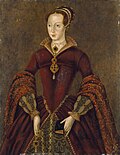| Years |
|---|
| Millennium |
| 2nd millennium |
| Centuries |
| Decades |
| Years |



| 1554 by topic |
|---|
| Arts and science |
| Leaders |
| Birth and death categories |
| Births – Deaths |
| Establishments and disestablishments categories |
| Establishments – Disestablishments |
| Works category |
| Gregorian calendar | 1554 MDLIV |
| Ab urbe condita | 2307 |
| Armenian calendar | 1003 ԹՎ ՌԳ |
| Assyrian calendar | 6304 |
| Balinese saka calendar | 1475–1476 |
| Bengali calendar | 960–961 |
| Berber calendar | 2504 |
| English Regnal year | 1 Mar. 1 – 1 Ph. & M. |
| Buddhist calendar | 2098 |
| Burmese calendar | 916 |
| Byzantine calendar | 7062–7063 |
| Chinese calendar | 癸丑年 (Water Ox) 4251 or 4044 — to — 甲寅年 (Wood Tiger) 4252 or 4045 |
| Coptic calendar | 1270–1271 |
| Discordian calendar | 2720 |
| Ethiopian calendar | 1546–1547 |
| Hebrew calendar | 5314–5315 |
| Hindu calendars | |
| - Vikram Samvat | 1610–1611 |
| - Shaka Samvat | 1475–1476 |
| - Kali Yuga | 4654–4655 |
| Holocene calendar | 11554 |
| Igbo calendar | 554–555 |
| Iranian calendar | 932–933 |
| Islamic calendar | 961–962 |
| Japanese calendar | Tenbun 23 (天文23年) |
| Javanese calendar | 1472–1473 |
| Julian calendar | 1554 MDLIV |
| Korean calendar | 3887 |
| Minguo calendar | 358 before ROC 民前358年 |
| Nanakshahi calendar | 86 |
| Thai solar calendar | 2096–2097 |
| Tibetan calendar | 阴水牛年 (female Water-Ox) 1680 or 1299 or 527 — to — 阳木虎年 (male Wood-Tiger) 1681 or 1300 or 528 |
Year 1554 ( MDLIV ) was a common year starting on Monday of the Julian calendar.




